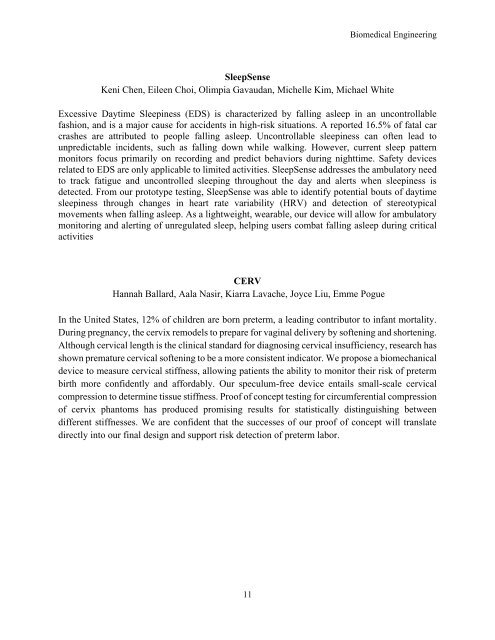Senior Design Expo 2022
You also want an ePaper? Increase the reach of your titles
YUMPU automatically turns print PDFs into web optimized ePapers that Google loves.
Biomedical Engineering<br />
SleepSense<br />
Keni Chen, Eileen Choi, Olimpia Gavaudan, Michelle Kim, Michael White<br />
Excessive Daytime Sleepiness (EDS) is characterized by falling asleep in an uncontrollable<br />
fashion, and is a major cause for accidents in high-risk situations. A reported 16.5% of fatal car<br />
crashes are attributed to people falling asleep. Uncontrollable sleepiness can often lead to<br />
unpredictable incidents, such as falling down while walking. However, current sleep pattern<br />
monitors focus primarily on recording and predict behaviors during nighttime. Safety devices<br />
related to EDS are only applicable to limited activities. SleepSense addresses the ambulatory need<br />
to track fatigue and uncontrolled sleeping throughout the day and alerts when sleepiness is<br />
detected. From our prototype testing, SleepSense was able to identify potential bouts of daytime<br />
sleepiness through changes in heart rate variability (HRV) and detection of stereotypical<br />
movements when falling asleep. As a lightweight, wearable, our device will allow for ambulatory<br />
monitoring and alerting of unregulated sleep, helping users combat falling asleep during critical<br />
activities<br />
CERV<br />
Hannah Ballard, Aala Nasir, Kiarra Lavache, Joyce Liu, Emme Pogue<br />
In the United States, 12% of children are born preterm, a leading contributor to infant mortality.<br />
During pregnancy, the cervix remodels to prepare for vaginal delivery by softening and shortening.<br />
Although cervical length is the clinical standard for diagnosing cervical insufficiency, research has<br />
shown premature cervical softening to be a more consistent indicator. We propose a biomechanical<br />
device to measure cervical stiffness, allowing patients the ability to monitor their risk of preterm<br />
birth more confidently and affordably. Our speculum-free device entails small-scale cervical<br />
compression to determine tissue stiffness. Proof of concept testing for circumferential compression<br />
of cervix phantoms has produced promising results for statistically distinguishing between<br />
different stiffnesses. We are confident that the successes of our proof of concept will translate<br />
directly into our final design and support risk detection of preterm labor.<br />
11








